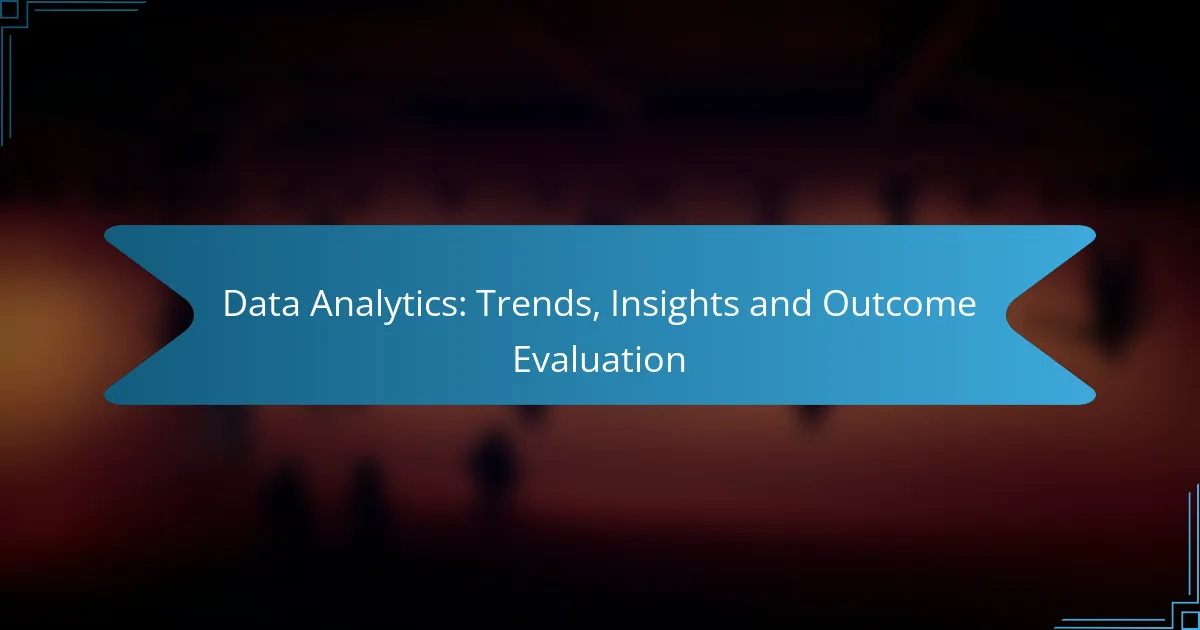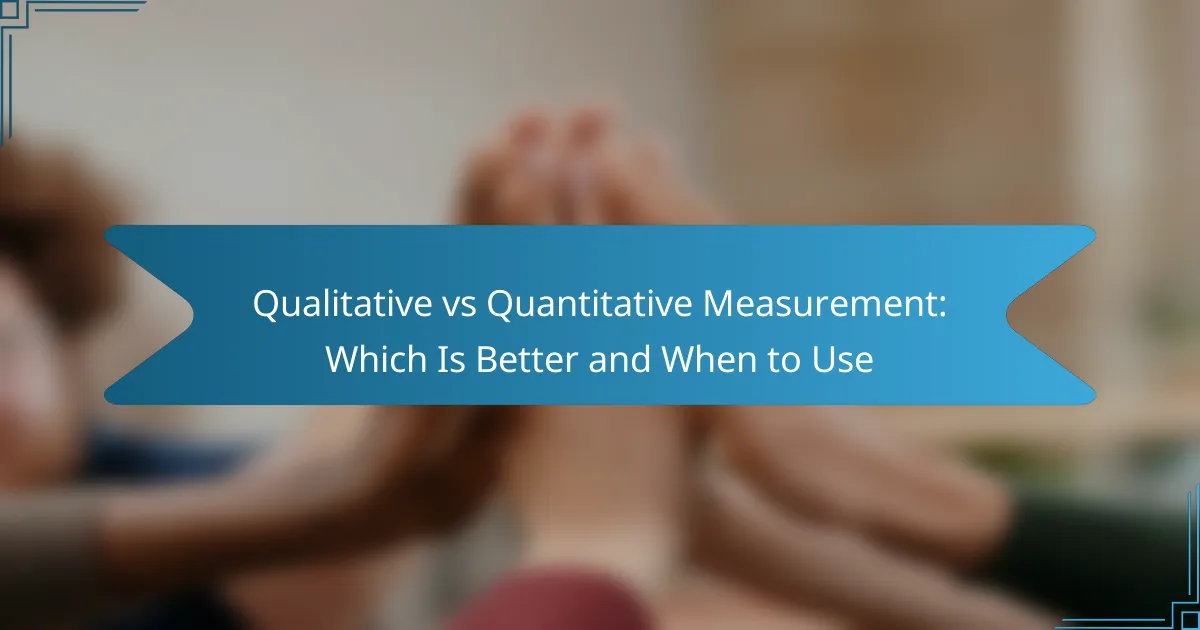Data analytics is rapidly evolving, driven by trends such as the integration of artificial intelligence and real-time data processing, alongside a growing focus on data privacy. Organizations are increasingly leveraging these advancements to enhance decision-making and operational efficiency. Evaluating the outcomes of data analytics initiatives is crucial, as it allows businesses to measure effectiveness through key performance indicators and refine their strategies for better results.

What Are the Key Trends in Data Analytics?
Key trends in data analytics include the growing integration of artificial intelligence, real-time data processing capabilities, and increased emphasis on data privacy regulations. These trends shape how organizations leverage data for decision-making and operational efficiency.
Increased Use of AI and Machine Learning
The use of AI and machine learning in data analytics is rapidly expanding, enabling organizations to automate processes and gain deeper insights from their data. These technologies can analyze vast datasets quickly, identifying patterns and trends that would be difficult for humans to detect.
Companies are increasingly employing AI-driven tools for predictive modeling, customer segmentation, and anomaly detection. For instance, retailers use machine learning algorithms to forecast inventory needs based on historical sales data and seasonal trends.
Real-time Data Processing
Real-time data processing allows organizations to analyze and act on data as it is generated, leading to faster decision-making. This capability is crucial for industries like finance and e-commerce, where timely insights can significantly impact performance.
Technologies such as stream processing frameworks enable businesses to handle continuous data flows, allowing for immediate responses to changing conditions. For example, financial institutions use real-time analytics to detect fraudulent transactions as they occur.
Data Privacy Regulations Impact
Data privacy regulations, such as the GDPR in Europe and CCPA in California, are significantly influencing data analytics practices. Organizations must ensure compliance with these laws, which often require transparency in data collection and processing practices.
Failure to comply with these regulations can lead to substantial fines and damage to reputation. Companies are increasingly investing in data governance frameworks to manage compliance effectively while still leveraging analytics for business growth.
Integration of IoT Data
The integration of Internet of Things (IoT) data into analytics frameworks is becoming essential as more devices generate vast amounts of data. This trend allows organizations to gain insights from real-time data collected from sensors and connected devices.
For example, manufacturers use IoT data to monitor equipment performance and predict maintenance needs, reducing downtime and operational costs. The challenge lies in effectively managing and analyzing this data to derive actionable insights.
Focus on Predictive Analytics
Predictive analytics is gaining traction as organizations seek to anticipate future trends and behaviors based on historical data. This approach enables businesses to make informed decisions and optimize their strategies proactively.
By employing statistical algorithms and machine learning techniques, companies can forecast customer behavior, market trends, and operational outcomes. For instance, healthcare providers use predictive analytics to identify patients at risk of developing chronic conditions, allowing for early intervention and better patient care.

How to Evaluate Data Analytics Outcomes?
Evaluating data analytics outcomes involves assessing the effectiveness of analytics initiatives through measurable indicators. By focusing on key performance metrics, organizations can determine the impact of their data-driven decisions and refine their strategies accordingly.
Define Clear KPIs
Establishing clear Key Performance Indicators (KPIs) is essential for evaluating data analytics outcomes. KPIs should align with business objectives and provide quantifiable measures of success, such as revenue growth, customer retention rates, or operational efficiency.
When defining KPIs, consider both leading and lagging indicators. Leading indicators predict future performance, while lagging indicators reflect past results. A balanced approach ensures comprehensive evaluation.
Utilize A/B Testing
A/B testing, or split testing, allows organizations to compare two versions of a variable to determine which performs better. This method is particularly useful for evaluating changes in marketing strategies, website design, or product features.
To conduct effective A/B tests, ensure a sufficient sample size and a clear hypothesis. Analyze results based on statistical significance to draw reliable conclusions. Avoid common pitfalls like testing too many variables at once, which can complicate results.
Implement Data Visualization Tools
Data visualization tools transform complex data sets into understandable visual formats, making it easier to evaluate outcomes. These tools can highlight trends, patterns, and anomalies that may not be apparent in raw data.
Choose visualization tools that suit your data and audience. Options range from simple charts and graphs to interactive dashboards. Ensure that visualizations are clear and focused on the KPIs established earlier, facilitating informed decision-making.

Which Tools Are Essential for Data Analytics?
Essential tools for data analytics include software and platforms that facilitate data collection, visualization, and analysis. Choosing the right tool depends on your specific needs, such as the type of data you handle and the insights you aim to derive.
Google Analytics
Google Analytics is a powerful tool primarily used for tracking and reporting website traffic. It provides insights into user behavior, allowing businesses to understand how visitors interact with their sites.
To effectively use Google Analytics, set up goals that align with your business objectives, such as conversions or user engagement. Regularly review reports to identify trends and areas for improvement, ensuring you adapt your strategies based on the data collected.
Tableau
Tableau is a leading data visualization tool that helps users create interactive and shareable dashboards. It connects to various data sources, enabling users to visualize complex data sets easily.
When using Tableau, focus on designing clear and intuitive dashboards that highlight key metrics. Utilize its drag-and-drop interface to simplify the visualization process, and consider sharing your dashboards with stakeholders for collaborative insights.
Power BI
Power BI is a business analytics tool by Microsoft that provides interactive visualizations and business intelligence capabilities. It allows users to create reports and dashboards from a variety of data sources.
To maximize Power BI’s potential, take advantage of its integration with other Microsoft products and cloud services. Regularly update your data models and reports to reflect real-time insights, and explore its AI features to enhance data analysis.

What Are the Challenges in Data Analytics?
Data analytics faces several challenges that can hinder effective decision-making and insights. Key issues include data quality, skill gaps in the workforce, and difficulties in integrating diverse data sources.
Data Quality Issues
Data quality issues arise when the information collected is inaccurate, incomplete, or inconsistent. Poor data quality can lead to misleading insights and flawed decision-making, which can ultimately affect business performance.
To mitigate these issues, organizations should implement data validation processes and regularly audit their datasets. Establishing clear data governance policies can also help maintain high data quality standards.
Skill Gaps in Workforce
Skill gaps in the workforce refer to the lack of necessary expertise among employees to effectively analyze and interpret data. Many organizations struggle to find qualified data analysts and data scientists, which can slow down analytics initiatives.
To address this challenge, companies should invest in training programs and consider partnerships with educational institutions. Encouraging continuous learning and providing access to online courses can help bridge the skills gap.
Data Integration Difficulties
Data integration difficulties occur when organizations attempt to combine data from various sources, which may use different formats or structures. This can lead to inefficiencies and hinder the ability to derive comprehensive insights.
To improve data integration, businesses should adopt standardized data formats and utilize integration tools that facilitate seamless data merging. Establishing a centralized data repository can also streamline access and analysis across departments.

How to Choose the Right Data Analytics Strategy?
Selecting the right data analytics strategy involves understanding your specific business goals and aligning them with the appropriate analytical methods. Consider factors such as the type of data available, the resources at your disposal, and the insights you aim to achieve.
Assess Business Needs
Identifying your business needs is the first step in choosing a data analytics strategy. Determine what questions you want answered, such as improving customer satisfaction or optimizing operational efficiency. This clarity will guide your choice of analytics techniques.
For example, if your goal is to enhance marketing efforts, you might focus on customer segmentation and predictive analytics. Conversely, if you aim to streamline operations, consider process analytics or performance metrics.
Evaluate Available Resources
Assessing your available resources is crucial for implementing an effective data analytics strategy. This includes evaluating your team’s expertise, the technology stack, and the budget allocated for analytics initiatives. Understanding these factors will help you determine what is feasible.
For instance, if you have a limited budget, you may want to start with open-source analytics tools or cloud-based solutions that offer scalability without significant upfront costs. Additionally, consider investing in training for your team to enhance their analytical skills.



